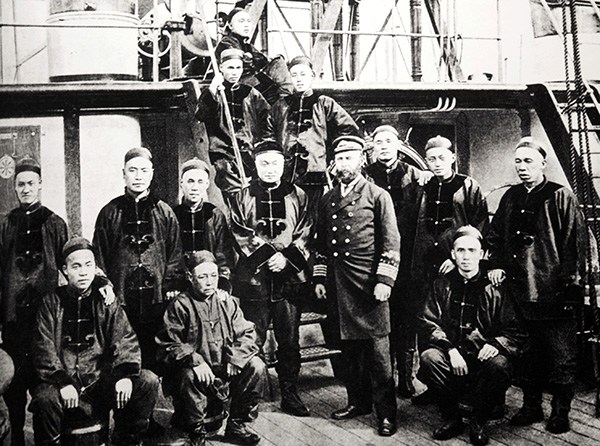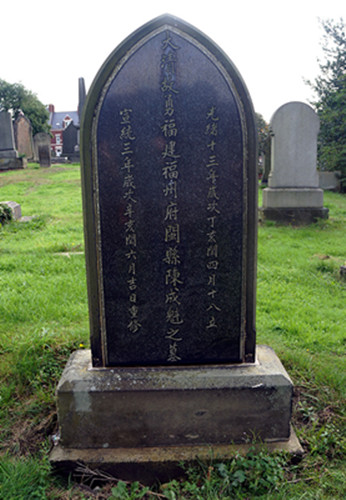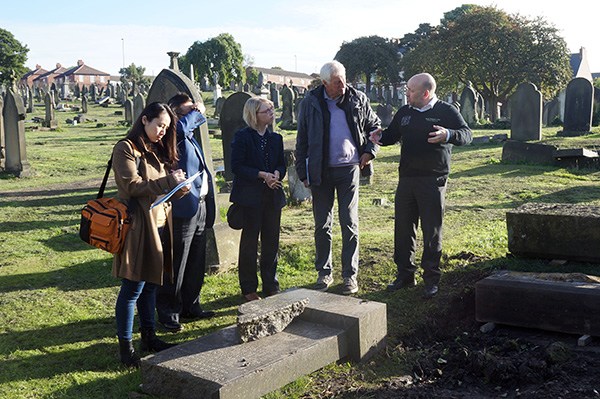Foreign field will forever be home

Crew members pose on the Zhiyuan, a warship purchased from Britain for the Beiyang Fleet. (Photo/CHINA DAILY)
Final preparations are underway for a project that will restore the graves of five Chinese sailors who died in the 1880s in Newcastle-upon-Tyne, a city in northeastern England.
Experts consider the tombs to be historical artifacts that mark the birth of the Beiyang or Northern Fleet, the most powerful naval force assembled by China during the Qing Dynasty (1644-1911), which was bolstered by four battle cruisers that China purchased from the United Kingdom between 1881 and 1887.
Located in St. John's Cemetery in the Elswick district of the city, the graves-three of which have collapsed and are half-sunken-contain the remains of Yuan Peifu, Gu Shizhong, Lian Jinyuan, Chen Shoufu and Chen Chengkui, members of the first two naval delegations that China sent to Europe.
The five men died from unidentified illnesses while waiting to bring the cruisers back to China to form the most powerful navy in Asia at the time, according to Chen Yue, president of the Chinese Naval Historical Institute, who specializes in studies of the period.
Despite its power, though, the fleet was defeated by Imperial Japan during the first Sino-Japanese War (1894-95), signaling the end of a modernization movement under the Qing and the start of Japanese colonialism across Northeast Asia.
Last year, photos of the cracked tombstones were posted online by a Chinese student at the Royal College of Art in London and quickly attracted the attention of the China Foundation for Cultural Heritage Conservation, a nonprofit organization.
In December, the foundation launched its first global crowdfunding campaign with the aim of raising 460,000 yuan ($67,000) to pay for the restoration work, according to Li Xiaojie, the foundation's president. The campaign is ongoing.
The Chinese government spends about 8 billion yuan every year on the protection of relics, but most of the projects are in China, he added.
The tombstones in Newcastle-Upon-Tyne are Chinese landmarks overseas, and as such are of great historical value, according to Chen Yue, president of the Chinese Naval Historical Institute: "They are rare historical artifacts of the Qing's modernization movement and Chinese naval history in general."

The grave of a sailor buried in the 1880s in Newcastle-upon-Tyne, England. (Photo/CHINA DAILY)
The China Foundation for Cultural Heritage Conservation and the Newcastle city government have now approved the survey, budget and repair plan. Given the current rate at which money is being donated, the repairs will begin in April and will be concluded by August, said Li Xiaojie, the foundation's president.
"The five sailors can rest peacefully knowing that even after all these years, people back home still care about them," he said. "This is a project full of human warmth and love."
Repairing history
In September, Zhang Rong, the chief engineer for the tombstone restoration project, and his team, which is employed by Li's foundation, flew to Newcastle to clean, inspect the graves, and discuss the restoration plans with local experts and city officials.
Initially, Zhang, who is also deputy chief engineer of the Beijing Guowenyan Cultural Heritage Conservation Center, thought the work would be easy, but he quickly realized that his optimism was misplaced.
"It turned out to be the trickiest project I have ever worked on. The tombstones are immoveable historical relics left by Chinese people in a foreign country," he said, adding that because of their rarity, the graves are managed by the local cemetery and protected under British law.
"The repairs must adhere to the protection laws and standards of both countries," Zhang said. "China has no precedent in dealing with such artifacts, so we have to start everything from scratch."
The foundation and the Newcastle city government held extensive negotiations to ensure the project would run smoothly. "We went through each item line by line, trying to find common ground and iron out any differences," Zhang said. "It was worth the time because we learned so much during the process, especially about improving our standards."
For example, in China, repairing broken tombstones only requires the stones to be glued back together. In Britain, however, in addition to gluing, steel reinforcing rods have to be inserted too, "so the tombstones won't break and fall on visitors", Zhang said.
Simon Richmond, owner of Joseph Richmond & Son Memorials, a family-run team of stonemasons in Newcastle, said certain sections of the graves need to be replaced because they are badly damaged.

Members of an inspection team from the China Foundation for Cultural Heritage Conservation discuss restoration plans with a memorial stonemason and local councillors in Newcastle-upon-Tyne, England. (Photo: ZHANG RONG/CHINA DAILY)
"But we are trying to keep as much of the original material as possible to maintain the historical integrity of the memorials that have been here for a very long time," Richmond said, adding that the main challenge is the size of the headstones, which are so large that special lifting equipment will be needed to carry out the work.
The northern hemisphere weather will also present challenges, so the bulk of the work will be carried out during the summer months to avoid adverse conditions, such as rain and snow, he said.
'A great sacrifice'
According to the archives at Newcastle Civic Centre, the first two graves were purchased by the Chinese government in 1881, and the other three in 1887. They cost 5 pounds each at the time, which would equate to about 1,000 pounds ($1,267) per grave in modern terms, according to Alan Macfarlane, historian and professor emeritus at King's College, Cambridge University.
"It does not seem very much, but in fact, at the time, the Chinese were relatively short of foreign currency, so it really was a great sacrifice," he said. "It was really a wonderful thing that was done because so many Chinese sailors were lost all over the world, and very, very few of them have been remembered. It is marvelous that we are now able to remember one or two of them."
The Northern Britain Chinese Entrepreneurs Association, which is based in Newcastle, has become a major player in the restoration project, which is of great significance to the Chinese community in Newcastle and northeast England, according to Xu Lei, the association's executive vice-president.
"In addition to the historical importance of the project itself, I believe that working together with the local government and community helps overseas Chinese in Newcastle to better integrate with the local community. It also provides local people a great opportunity to understand some Chinese history and traditions," he said.
Now, with one global restoration project under his belt, Li believes similar operations will become more common, and said crowdfunding will make it easier for members of the public to participate in the preservation of relics.
"We all have a responsibility to preserve our history," he said.

- Back _articles: China means opportunity to 500 mln EU consumers: European expert
- Next _articles: Italy aims to become technological partner of China: scholar